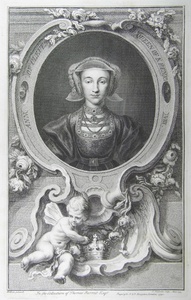| Method | Copper engraving |
| Artist | Jacobus Houbraken after Hans Holbein the Younger |
| Published | Impenssis J. & P. Knapton Londini 1740 [1743-52] |
| Dimensions | Image 361 x 225 mm, Plate 375 x 235 mm, Sheet 492 x 316 mm |
| Notes |
Portrait of Anne of Cleves, looking directly at the viewer, and set within an inscribed decorative oval. She wears an embellished headdress and dress, with jewels around her neck. Below the portrait, a putto is shown alongside a crown. This portrait of Anne of Cleves is from Thomas Birch's The Heads of Illustrious Persons of Great Britain. Although the publication line features the date 1740, the print was not published by J & P Knapton in London until at least 1743. The portraits featured in the series, which were engraved by Jacob Houbraken and George Vertue, were originally issued from 1737 onwards in portfolios of four portraits. Between 1743 and 1752, the series was published by John and Paul Knapton in London in the form of Birch's The Heads of Illustrious Persons of Great Britain, and contained biographies alongside the portraits. The number of plates included varied from edition to edition. Although the majority contained 108 plates, some editions contained as many as 120. Houbraken was responsible for producing a large proportion of the portraits, with Vertue only engraving around seven. The ornamental surroundings featured on the plates were engraved prior to the portraits, and were done so by Hubert-François Gravelot. Anne of Cleves (1515 - 1557) was the fourth wife of King Henry VIII. Their marriage only lasted a few months, from the January until the July of 1540, and was annulled on the grounds on non-consummation. Following the annulment, Anne received a generous settlement from Henry VIII, including Richmond Place, and Hever Castle. With Anne and Henry's marriage being so short, Anne was never crowned queen consort. Jacob, or Jacobus, Houbraken (1698-1780) was a Dutch portrait engraver, and dealer and collector of Rembrandt's etchings. Born in Dordrecht, he was the son of the artist Arnold Houbraken. In 1707 he moved to Amsterdam, where he assisted his father on a book of the lives of the Dutch Golden Age artists, entitled De Groote Schouburgh der Nederlantsche konstschilders en schilderessen (1718-1721). Between 1743 and 1752, Houbraken worked with George Vertue on Thomas Birch's Heads of Illustrious Persons of Great Britain. He also engraved the portraits for Jan van Gool's Nieuwe schouburg der Nederlantsche kunstschilders (1750-51). Between 1752 and 1759, he worked on Jan Wagenaar's Vaderlandsche historie, which was published by Isaac Tirion. Hans Holbein the Younger (1497 - 1543) was a painter, draughtsman and designer of woodcuts. He also worked with glass-paintings, metalwork, and jewellery. Holbein was born in Augsburg. He worked in Basel as a journeyman at the end of 1515, and was first employed there with Ambrosius by humanist scholars and their printers. In 1519, he was admitted to the painters' guild. With an introduction from Erasmus to Sir Thomas More he left for England at the end of August 1526 and stayed for two years working in the court circle before returning to Basel. He returned to England in 1532 and, under the patronage of Henry VIII, he produced a succession of magnificent portraits. The most famous of which was the mural painting glorifying the Tudor dynasty in the Whitehall Palace. It was regrettably destroyed in the fire of 1698. O'Donoghue 3, Ver Huell 12 Condition: Some discolouration and time toning to margins. |
| Framing | unmounted |
| Price | £80.00 |
| Stock ID | 40110 |

